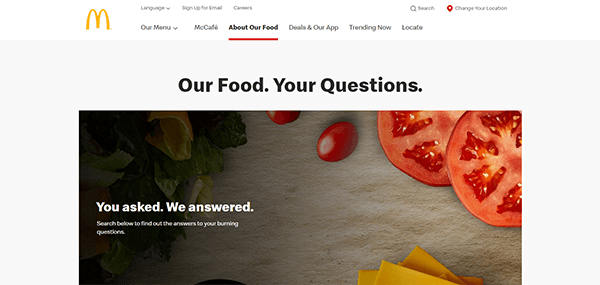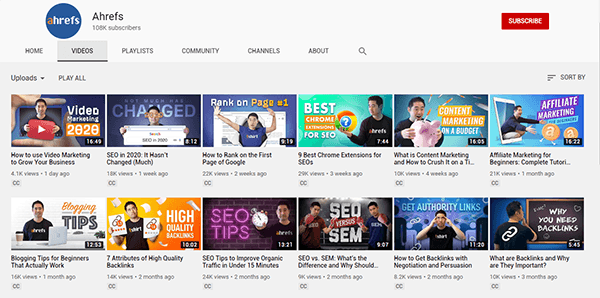As more and more marketers have begun to realize the power of digital marketing, content marketing has quickly become the name of the game.
While many may be under the mistaken impression that it all boils down to publishing content on your business website, it’s actually a whole lot more.
So let’s start with a definition.
Content marketing is a strategy that involves both creating and promoting unique and valuable content to a target audience.
The key here is “unique and valuable.” With so much content getting churned out every day, it’s critical that you put in the extra effort to stand out from the crowd.
It all starts with a mindset. Content marketing ideas shouldn’t start with the service or product you want to promote. They should begin with an idea as to how you can be useful and helpful to potential leads and customers.
Here’s an example, to simplify:
McDonald’s launched a campaign called “Our Food. Your Questions.”.

The campaign aimed to fix the fast-food giant’s growing image problem and position itself as a brand that’s committed to sustainability.
The forum somewhat forced the company to be more transparent with their customers.
It answered questions about how they source their ingredients, why they label their products a certain way, or how they prepare their products.
While the primary point of this content marketing strategy was consumer education, McDonald’s was able to improve its brand image by embracing transparency. Pretty cool, right?
Why Is Content Marketing Important?
Content marketing is unique in a sense. Unlike other forms of advertising, content offers information primarily but focuses on the way in which that information is delivered.
Articles, therefore, aren’t the only vehicle through which brands can leverage content to their advantage. Social media posts, videos, photos, podcasts, e-books, case studies, infographics, tutorials, and reviews all count as content as well.
Ahrefs, for example, is an SEO platform used primarily by agencies. They not only create long-form blog articles explaining SEO concepts, but they also maintain an excellent YouTube channel that offers video tutorials and guides to some of the more complex SEO tactics and strategies.

Of course, you’ve probably heard that content is the gift that keeps giving. And it’s true. Especially so if you take the time to invest in evergreen content.
Evergreen content (also known as cornerstone, or anchor content) is anything that you plan to continuously update and build upon, keeping it perpetually relevant for audiences and withstanding the test of time.
For examples of our own evergreen content, feel free to check out our guide to SEO pricing and our on-page SEO guide.
Just remember: Content marketing deals with informative and entertaining material. As such, most readers consider it far less intrusive than your typical display or print advertisement.
While most people will not be pleased to find a flyer tucked under their windshield wiper, they may indeed be happy to spend some time consuming sponsored media that actually helps them improve either their business or their lives.
Another perk to content marketing in the digital age is that its effects are easily trackable and measurable.
Using reports from Google Analytics or any of the other analytics software that produces SEO reports will grant deep insights into your marketing strategy efficacy and its effects on total conversions.
How to Build Your Content Marketing Strategy
To ensure your content marketing efforts are effective, you’ll want to give careful thought during the strategic planning stage.
Identifying a target audience is only the tip of the iceberg, but let’s start there before going any further.
Determine your target audience
Before creating any content, you’ll need to identify who you want to find and read/view it.
You can start this process by looking at your product, competitors, and current customers. See what they all have in common and what problems they are trying to solve.
To do this using Google Analytics, click on “Audience” to roll out the drop-down menu. You will then see options for different visitor filters.
For example, if you want to see the age brackets of your site’s visitors, click on Demographic > Age. It will show you a line graph of visitors according to age group.
Or if you want to compare the number of new visitors as opposed to your returning audience, select Behavior > New vs. Returning.
Using these Audience filters allows you to drill down your visitors into categories and help you understand the kind of traffic your site is receiving.
Build a content schedule
Creating a content marketing strategy is all about consistency, especially when you’re new to writing your own blog. Start by building a content calendar and hold yourself and your team accountable to stick to it.
With a good content calendar schedule, you should be able to plot out your posts in advance. Factor in quarterly, monthly or annual goals, product launches, holidays, current content marketing trends, and other important information. After that, you can spend the rest of your time focusing on writing.
This is only increasingly important if you plan to invest in content beyond just blog articles. If there are other stakeholders involved, organizing everyone’s responsibilities and due dates in a central place becomes a force multiplier.
We use Trello for our own content calendar, but there are many options available, including dedicated services and apps like CoSchedule.
Leverage the right tools
Speaking of apps, you’ll need to find marketing tools that’ll speed up the content creation process.
While there are endless recommendations we could include here, we’ll focus on a few key areas.
- SEO – You’ll need an SEO tool of some type to help you with keyword research, copywriting optimization, etc. We recommend Ahrefs or SEMrush.
- Topic Discovery – You’ll also want to do some research to find out what topics are of particular relevance. Google Trends and BuzzSumo are both good choices with different pros and cons.
- Promotion – After your content is live, you’ll still have plenty of work to do. Promotion usually means regular social updates, reposting, and email outreach. For the social side of things, consider checking out MeetEdgar, SocialPilot, or HootSuite.
- “Uniqueness” – Plagiarism is as much of an issue online as it is in the classroom. While you can and should quote other useful sources (provided you include proper attribution), the bulk of your content should be original. It’s best to run your writing through a plagiarism checker like DupliChecker or Grammarly just to be safe.
Be Consistent With Your Content Quality
As we mentioned, consistency is key. But you want to think about quality consistency and not just publishing cadence.
The best way to ensure that you only publish high-quality content is by hiring an editor or by using a content editor tool.
By having someone check your articles, you’ll be able to avoid grammatical errors, factual inaccuracies, and improper branding. Remember, you’ll want to make sure your site is at optimal performance before posting your content.
But beyond that, here are a few avenues you can pursue to help take the bull by the horns.
Streamline your workflow
Regardless of whether you’re writing in-house, or working with freelancers or an external partner, organizing an efficient workflow can be a game-changer.
Here’s a good goal to strive for with your own content generation workflow.
Step 1: Pick a topic from your content calendar and assign it to a writer. Your brief should include the areas you want the writer to cover and the keywords you want him or her to include. Be as detailed as possible.
Step 2: It’s time to get the ball rolling. Start with research and eventually work on drafting the copy. In some cases, writers will take care of the images, so they’ll also need time for photo editing. Deadlines should be set but should always be within reason.
Step 3: Do quality control after the draft is submitted. Take note of sections that need to be revised. This exchange will go back and forth until both sides are satisfied.
Step 4: Publish the post. Don’t forget to promote your content on social media. After a few days or weeks, you can check analytics to see if the post is gaining traction.
This is just a boilerplate approach and should have steps added, removed, or modified as needed for your particular use-case.
Always invest in the research phase
Creating quality content involves keyword research.
By consistently posting well-researched articles, you can improve the quality of your content and make you a reliable resource for your intended audience.
After a while, it might seem like cutting corners on the research-phase wouldn’t be a big deal since you already know the space and your market and audience so well. But trust me, things change. And you won’t know unless you’re putting in the leg work upfront.
Embrace variety
Just because you’re maintaining a tone doesn’t mean you have to shut down the idea of experimenting with content ideas. If your articles are poorly written, stale, or just lacking in character, your audience will likely leave. Maybe not all at once, but over time, you’ll feel it.
So try spicing things up once in a while, and presenting information in different formats. Add some humor if that’s what your content or audience needs.
Most importantly, don’t be afraid of being creative.
A lot of business owners will want to leverage surveys to boost engagement with their website visitors. Quiz surveys and assessments can be added to service or product pages, which helps brands share expertise while collecting valuable lead data. Survey Anyplace is a tool we’d recommend trying if you’re new to implementing surveys on your site, as it’s particularly easy to use.
A Few Common Content Marketing Mistakes to Avoid
Some mistakes are inevitable, but the following are easily avoided, so take note of them and plan to avoid them so you don’t waste time and energy needlessly.
- Creating content without a clear takeaway — Reading any article, regardless of length, only to find that there’s no payoff will only frustrate your readers. Make sure your audience walks away from your post, knowing something they did not know before.
- Focusing on quantity over quality — There’s nothing wrong with publishing lots of articles. But only if you maintain its high standards of quality. When writers rush articles, they become susceptible to mistakes and inaccuracies. Therefore, make sure that the writer writes posts with care and great attention to detail.
- Writing for algorithms instead of people — Adding keywords to posts is essential. But it does not mean you should spam your posts. Keywords should still sound natural. If your article sounds like a robot wrote it, you’re doing it wrong.
Conclusion
Whether you like it or not, content marketing is here to stay. For most brands, it’ll be a beneficial and potentially game-changing avenue when employed thoughtfully.
Equipped with the information above, you should be well on your way to having a successful content marketing strategy.
If you have additional questions, check out the FAQ below.
If you know you need help with content marketing but simply don’t have the time, feel free to get in touch. We help businesses small and large employ content marketing to reach broad business goals and improve digital lead generation.
Frequently Asked Questions
What Is Good Content?
While it’s hard to determine exactly, people consider content informative if it’s able to convey an idea effectively. Aim to create pieces where you answer typical questions around your topic, that way you can engage your readers in one place. At a minimum, focus on reducing typos, using facts to state your case, and addressing the reader’s concerns.
What Should a Content Strategy Include?
It should specify a goal, an audience, platforms (social media, blog, etc.), and your niche. As we said before, factor in your business quarterly, monthly, or annual goals. Content should be written with purpose. You’ll also want to identify what metrics you’ll use to measure your results.
What Is an Example of Content Marketing?
Neil Patel published a post that features some of the best content marketing strategies from lesser-known companies.








